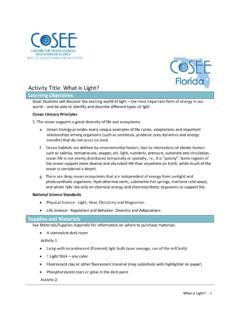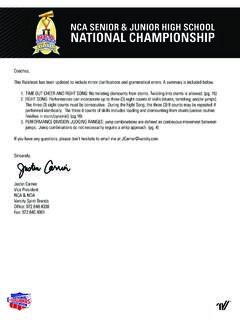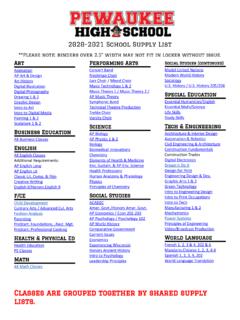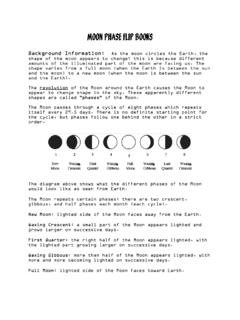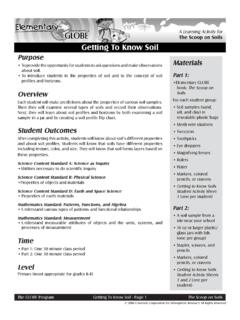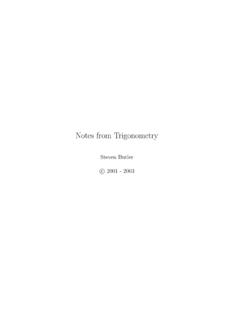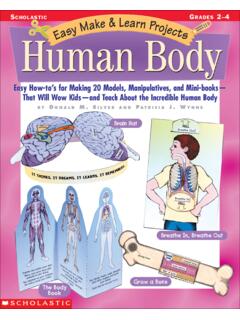Transcription of Activity Title: Introduction to Ocean Zones - COSEE.net
1 Introduction to Ocean Zones -- 1 Activity title : Introduction to Ocean Zones Learning Objectives Students will create a diagram of the Ocean Zones and determine what organisms live in each zone. Students will draw the appropriate scale to demark meters (and conversion to feet) from 0-6000m and draw the Zones that correspond to the geological structures of the Ocean basin. Finally, students will use their critical thinking skills to determine where in the Ocean each organism lives and place the organism in the habitat that is within the limitations for survival. Note that when students are drawing structures and creating organisms, they will not all be to scale. You must include a discussion of how scale plays a role in our understanding of how big or how deep the Ocean is (the tiniest portion of the Ocean , the top 200 meters is where all photosynthesis takes place).
2 Objectives: Students will be able to: Measure and draw a scale in meters of Ocean depths Identify Ocean Zones and geological structures in an Ocean basin Identify various organisms that live at each depth Explain why organisms are restricted to different depths Understand how to read depth profiles for light and temperature Ocean Literacy Principles: 1b. An Ocean basin's size, shape and features vary due to the movement of the earth's lithospheric plates. Earth's highest peaks, deepest valleys and flattest vast plains are all in the Ocean . 2a. The Ocean and life in the Ocean shape the features of the earth 4b. The first life is thought to have started in the Ocean . The earliest evidence of life is found in the Ocean .
3 5b. Most of life in the Ocean exists as microbes. 7. The Ocean is largely unexplored. Supplies and Materials A large butcher or poster type paper, measuring 12' x 6 ', or whatever size fits the room Multicolor markers, crayons, colored pencils, or sharpies Tape for hanging the diagram Large meter stick BEST OF COSEE HANDS-ON ACTIVITIES Introduction to Ocean Zones -- 2 Pictures of marine life from different depths that are glued onto cardboard or some other sturdy paper Double sided tape Background In order to begin to understand life below the seafloor, it is essential to grasp that the Ocean has many different habitats that are defined by the physical and chemical properties that exist at different depths.
4 The purpose of this Activity is to identify and describe different Zones of the Ocean and the organisms that live there. The Ocean is divided into 5 main Zones from the surface to the depths where light can no longer penetrate. These Zones are characterized by different physical and chemical properties, such as quantity and quality of light, pressure and temperature. These properties affect what life forms can exist within those limitations. This Activity introduces the microbial environment in the deep Ocean , and can be the foundation to explain geothermal processes, and the evolution of bacteria. Concept review questions: What is an Ocean basin and how is it formed? (Include references to continental shelf, continental slope, continental rise, abyssal plain, seamounts, hydrothermal vents, trench, and processes of plate tectonics, seafloor spreading, erosion and sedimentation) What is the photic zone and how does it compare in size to the other Ocean Zones ?
5 (The top 10 m is where most visible light occurs and then decreases in quality and quantity down to 200m. It is a very tiny fraction of the depths of the open Ocean ). What is a thermocline? (A thermocline is the thin but distinct layer in which temperature changes more rapidly with depth than it does in the layers above or below) How does light change depending on whether you are measuring light in the open Ocean vs. coastal waters? (In the open Ocean , where the water is the clearest, visible light can penetrate down to 150-200 m. near the coasts, light transmission varies depending on how turbid the water is, whether there is runoff and particulates in the water, and how deep it is.)
6 Light transmission may be has shallow as a few meters and as deep as 50 m.) What are some major physio-chemical variables that might limit an organism s survival in the Ocean (Light, temperature, pressure). What are some extreme conditions found in the deep Ocean and how is life supported? (Hydrothermal vents, sea mounts. Food webs are supported by microbes chemical reactions, called redox reactions, that use a number of different molecules as sources of energy in electron transport chains). Duration This lesson will take approximately 55 minutes. Audience This lesson is designed for grades K-12. Procedure ADVANCE PREPARATION Have all of the marine life already glued onto paper.
7 You may direct students to choose and prepare Introduction to Ocean Zones -- 3 the pictures. You can pre-label as much or as little as you want on the diagram depending on the grade level. PROCEDURE 1. Hang the paper for the diagram or lay it on the floor and divide the students up into 4 groups. 2. Groups 1 and 2: measure and label the meter scale on either side of the diagram from 0 m at the Ocean surface down to 6,000 meters and the geological structures of the Ocean basin (continental shelf, slope, rise and abyssal plain). 3. Group 3: work at the top of the diagram, drawing the surface of the Ocean and structures found at the surface (like a coral reef, a ship, a sailboat). 4.
8 Group 4: work on the bottom of the diagram, drawing a seamount, trench, hydrothermal vents Labels and features to include on diagram: Photic (sunlit) zone Aphotic (no light) zone Neritic system Benthic realm Pelagic realm Bathyal zone Abyssal zone Hadal zone Shoreline Sea level Coral reef Continental Shelf Continental slope Continental rise Submarine Canyon Abyssal Plain Seamount Guyot Trench Mid- Ocean Ridge Rift Valley Hydrothermal vent Sub-seafloor sediment Sub-seafloor aquifer 5. Student place different organisms at their appropriate depths in the Ocean . EXTENSIONS Grade range K-4: Pre-draw the depth lines and Ocean basin structures in the Ocean and show different shades of light to black on the diagram.
9 Discuss how the light changes as you go deeper, and that even though at depth there is almost no light or no light at all, there are still things that live there. Students can draw organisms or use string to create worms, cotton for hydrothermal vents, etc. and place the organisms where they belong at the appropriate depths. Introduction to Ocean Zones -- 4 Grade range 5-8: The objective is for students to identify the physical and chemical delineations of Ocean habitats, understand the relationship between organisms and their Ocean habitats and adaptations organisms make to live in extreme environments. Students will also use math skills in making a scale in meters and feet, creating depth profiles of temperature, light and salinity, and calculating percent differences in comparing sizes of different organisms.
10 Students will answer the question: How is a thermocline presented and interpreted? (Students will create the graph and interpret. (No matter how warm the surface layers are, between 300 and 1,000m beneath the surface the temperature falls to about 5 C). Grade 9-12: The objective is for students to understand how deep the Ocean is, and why organisms are limited to certain depths. They will explore the question of why the Ocean is mostly unexplored and what prevents humans from diving on SCUBA to explore the deep Ocean . How deep can a human dive on SCUBA? Students will investigate the relationship between depth and pressure. Students will identify the microbial processes that occur at depth and explore how these processes effect the carbon and nitrogen cycles.)

